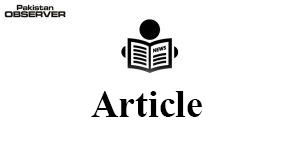Muhammad Raza Malik
INDIA illegally occupied the then princely state of Jammu and Kashmir by landing its troops in Srinagar on 27 October 1947. This action was totally against the wishes of the Kashmiri people and in gross violation of the Indian Independence Act and Partition Plan of 1947, under which the Indian British Colony was divided into two sovereign states, India and Pakistan. As per understanding behind the Partition Plan, the then princely states were free to accede either of the two countries on the basis of their geography and demography. Being a Muslim-majority state, with 87% Muslim population, Jammu and Kashmir had a natural tendency to accede to Pakistan. India claims to have obtained the accession of Jammu and Kashmir under the so-called Instrument of Accession (IoA) signed with the then Hindu ruler of the state, Maharaja Hari Singh. However, the fact is that the Maharaja, who had fled from Srinagar to Jammu due to the mass revolt against his autocratic rule, had no authority to do so. Many neutral observers deny the existence of such a document. They presented justified reasons to support their argument. They maintained that the so-called loA, if any that too conditional to the right to self-determination, was obtained under duress and in bad faith, and thus lacks any validity. Also, after signing standstill agreement with Pakistan, Hari Singh could not legally execute IoA in favour of India.
Furthermore, India has itself nullified the loA by its illegal actions of 05 August 2019. India is grossly violating in IIOJK the international humanitarian law (IHL), Geneva Conventions and the Hague Regulations that guarantee the right to self-determination and other rights to the people, prohibit demographic changes in any occupied territory and provision of unhindered access to health and education to the occupied population. According to IHL, occupation falls under the definition of international armed conflict. A territory is said to be occupied when a foreign power or hostile army exercises coercive control or authority over it even in the absence of the armed resistance and under this definition IIOJK is an occupied territory. As soon this situation arises, IHL or law of war and international human rights law (IHRL) come into force. These laws create a balance between the occupying power, the occupied territory as well as the civilian population.
The law of occupation has imposed certain responsibilities on the occupying state including the protection of the rights of the occupied population. However, India is not abiding by its international obligations and using killings, extrajudicial executions, arrests, torture, custodial disappearance and rape as a tool to suppress the Kashmiris’ struggle to get freedom from its yoke. Indian brutalities in IIOJK have been documented by reputed international human rights organizations and constitute war crimes. Narendra Modi-led fascist government brought about a substantial change in the disputed status of IIOJK on 05 August 2019. The UNSC through a resolution in 1948 acknowledged Jammu and Kashmir as a disputed territory and repeated that its permanent status would be determined by a referendum. The UNSC resolutions of 1951 and 1957 had reprimanded Indian unilateral attempts to modify the special status of the territory. The Simla Agreement of 1972 between Pakistan and India also prohibits unilateral action to alter the status of the disputed territory.
With this background, Kashmir’s case can be pursued before the United Nations Security Council (UNSC), the UN Human Rights Council (UNHRC), the International Court of Justice (ICJ) and the International Criminal Court (ICC). The maintenance of international peace and security is the primary responsibility of the UNSC. So, it can be stressed to play its role to enforce its own resolutions on Kashmir for the sake of peace and security in South Asia. The UNSC has the power to call upon the parties to settle their dispute through negotiation, enquiry, mediation, conciliation, arbitration, judicial settlement, resort to regional agencies or arrangements, or other peaceful means of their own choice. Thus, the UNSC can be asked to direct the parties that the Kashmir dispute is settled through judicial settlement by the ICJ.
Further, offences of genocide, crimes against humanity, war crimes and the crime of aggression fall under Article 5 of the Rome Statute of the ICC. As Pakistan is not a party to the Rome Statute, it cannot directly invoke the jurisdiction of ICC. However, under Article 13(b) of ICC, the UNSC can be approached to refer the offences of genocide, crimes against humanity, and the crime of aggression in IOJK to the ICC. The UNSC must be persuaded to refer the Kashmir dispute to the ICJ (for judicial settlement) and to the ICC (for the investigation, trial, and punishment for India’s crimes in Kashmir). Finally, the UNSC should also be convinced to enforce ‘economic sanctions’ against India and also “call for the use of armed forces” to “restore international peace and security” and to stop India’s state terrorism in IIOJK.
—The writer is a Senior News Editor at Kashmir Media Service.










